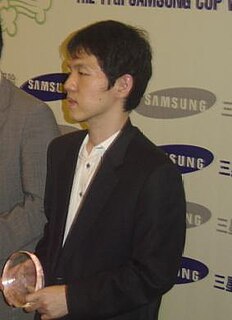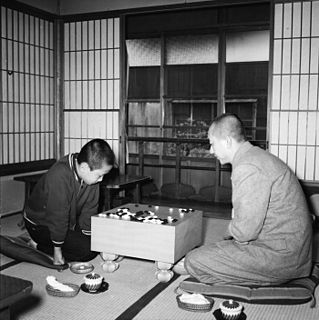Titles & runners-up
| Title | Years Held |
|---|---|
| Current | 1 |
| 2005 |
| Title | Years Lost |
|---|---|
| Defunct | 4 |
| 2001, 2002 | |
| 2001 |
| Kim Shushun | |
|---|---|
| Full name | Kim Shushun |
| Kanji | 金秀俊 |
| Kana | キムスジュン |
| Hangul | 김수준 |
| Hanja | 金秀俊 |
| Revised Romanization | Gim Su-jun |
| McCune–Reischauer | Kim Su-chun |
| Born | January 24, 1979 South Korea |
| Residence | Japan |
| Teacher | Cho Chikun |
| Turned pro | 1996 |
| Rank | 9 dan |
| Affiliation | Nihon Ki-in Tokyo branch |
Kim Shushun (born January 24, 1979), also known as Kin Hidetoshi, Kim Shujun, or Kim Sujun, is a professional Go player.
Kim became a professional in 1996. [1] In 2007, he was promoted to 8 dan. His teacher is Cho Chikun. He made it to the final of the 16th NEC Shun-Ei, only to be beaten by Mizokami Tomochika. Coincidentally, he played the game on the same day as his teacher, Cho Chikun, played in the final of the NEC Cup. He won his 400th career game in 2006. [2]
| Title | Years Held |
|---|---|
| Current | 1 |
| 2005 |
| Title | Years Lost |
|---|---|
| Defunct | 4 |
| 2001, 2002 | |
| 2001 |
| Rank | Year | Notes |
|---|---|---|
| 1 dan | 1996 | |
| 2 dan | 1996 | |
| 3 dan | 1997 | |
| 4 dan | 1998 | |
| 5 dan | 1999 | |
| 6 dan | 2000 | |
| 7 dan | 2002 | |
| 8 dan | 2007 | |
| 9 dan | 2018 |

Go is an abstract strategy board game for two players, in which the aim is to surround more territory than the opponent. The game was invented in China more than 2,500 years ago and is believed to be the oldest board game continuously played to the present day. A 2016 survey by the International Go Federation's 75 member nations found that there are over 46 million people worldwide who know how to play Go and over 20 million current players, the majority of whom live in East Asia.

Lee Chang-ho is a South Korean professional Go player of 9-dan rank. He is regarded by many as the best Go player of the late 1990s and early 2000s. He was a student of Cho Hun-hyun 9-dan. He is the second youngest to become a professional Go player in South Korean history behind Cho Hun-hyun. He is the only player to have won all eight international competitions at least once.

Cho Hunhyun is a South Korean 9-dan professional Go player. Considered one of the greatest players of all-time, Cho reached professional level in Korea in 1962. Since then, Cho has amassed 150 professional titles, more than any player in the world. He thrice held all of the open tournaments in Korea in 1980, 1982 and 1986. Cho has also won 11 international titles, third most in the world behind Lee Chang-ho (21) and Lee Sedol (15). He reached 1,000 career wins in 1995.

In the history of go in Japan, the four go houses were four major schools of go instituted, supported, and controlled by the state, at the beginning of the Tokugawa shogunate. At roughly the same time shogi was organised into three houses. Here "house" implies institution run on the recognised lines of the iemoto system common in all Japanese traditional arts. In particular the house head had, in three of the four cases, a name handed down: Inoue Inseki, Yasui Senkaku, Hayashi Monnyu. References to these names therefore mean to the contemporary head of house.
Cho Chikun25th HoninboHonorary Meijin is a professional Go player and a nephew of Cho Namchul. His total title tally of 75 titles is the most in the history of the Japanese Nihon Ki-in. Cho is the first player to hold the top three titles—Kisei, Meijin, and Honinbo—simultaneously which he did for three years in a row. Cho is the first in history to win all of the "Top 7" titles in Japan which he achieved by winning the Oza in 1994. Cho U in 2011 and Iyama Yuta in 2013 would duplicate this feat, both by winning the Kisei. He is also one of the 'Six Supers' Japanese players that were most celebrated in the late twentieth century, along with Rin Kaiho, Otake Hideo, Takemiya Masaki, Kato Masao and his classmate and arch-rival Kobayashi Koichi.

Rin Kaihō or Lin Haifeng is a professional Taiwanese Go player who made his name in Japan. He is, along with Cho Chikun, Kobayashi Koichi, Otake Hideo, Takemiya Masaki and Kato Masao, considered one of the 'Six Supers' that dominated Japanese Go world in the last three decades of the twentieth century.
Cho U is a Taiwanese professional Go player. He currently ranks 6th in the most titles won by a Japanese professional; his NEC Cup win in 2011 put him past his teacher Rin Kaiho and Norimoto Yoda. Cho is the first player in history to have held five of the top seven major titles simultaneously with Iyama Yuta being the second. Cho U, Naoki Hane, Keigo Yamashita and Shinji Takao make up the group of players in Japan called the "Four Heavenly Kings". His wife is one of Japan's best female go professionals, Izumi Kobayashi, the great Kitani's granddaughter and daughter of Kobayashi Koichi.
Chen Yaoye is a Chinese professional Go player.
Yuta Iyama Kisei, Honinbo, Meijin, Gosei is a Japanese professional Go player. In April 2016, he became the first player in Japanese history to hold all seven major titles simultaneously. In January 2018, Iyama became the first professional Go player to be awarded Japan's People's Honour Award.
Hideyuki Fujisawa, also known as Shuko Fujisawa, was a Japanese professional Go player. A younger uncle of another professional, Hosai Fujisawa.
Koichi Kobayashi is a Japanese Go player. He is one of the 'Six Supers' who championed Japanese Go in the last three decades of Japanese Go.
Cho Sonjin is a professional Go player.
The 10th Kisei was the 10th edition of the Kisei tournament. Since Cho Chikun won the previous year, he is given an automatic place in the final. Twelve players battled in a knockout tournament to decide the final 2. Those two would then play each other in a best-of-3 match to decide who would face Cho. Koichi Kobayashi became the challenger after beating Masao Kato 2 games to 1, and went on to defeat Cho Chikun 4 games to 2.
The 19th Kisei was the 19th edition of the Kisei tournament of the board game go, in 1995. Since Cho Chikun won the previous year, he was given an automatic place in the final to defend his title. Sixteen players battled in a single elimination tournament to decide the final 2. Those two would then play each other in a best-of-7 match to decide who would face Cho. Kobayashi Satoru became the challenger after beating Kobayashi Koichi, but lost 4 games to 2 against Cho.
The 20th Kisei 20th iteration of the Kisei tournament, a tournament in the board game go. It was won by Cho Chikun and held in 1996. The first match was played outside Japan, in Amsterdam, the Netherlands. Chikun won 4 games to 3 over Kobayashi Satoru in the final.
The 11th LG Cup professional Go tournament was won by Zhou Junxun. It featured:
Takehisa Matsumoto is a professional go player.
The 18th Agon Cup began on 21 April 2011-1 October 2011. Two Korean amateur players were invited to the preliminaries, with both qualifying. Ha Sungbong defeated professionals Yanigasawa Satoshi and Furuya Yutaka. Kim Sungjin defeated 25th Honinbo and Japan's top title holder Cho Chikun. He also defeated Kato Atsushi. In the main tournament, he was knocked out by Iyama Yuta Meijin in the first round. Iyama Yuta came out as the winner. He beat Yamashita Keigo at the final. The winner's prize was ¥10,000,000.
| This biographical article relating to a South Korean Go figure is a stub. You can help Wikipedia by expanding it. |